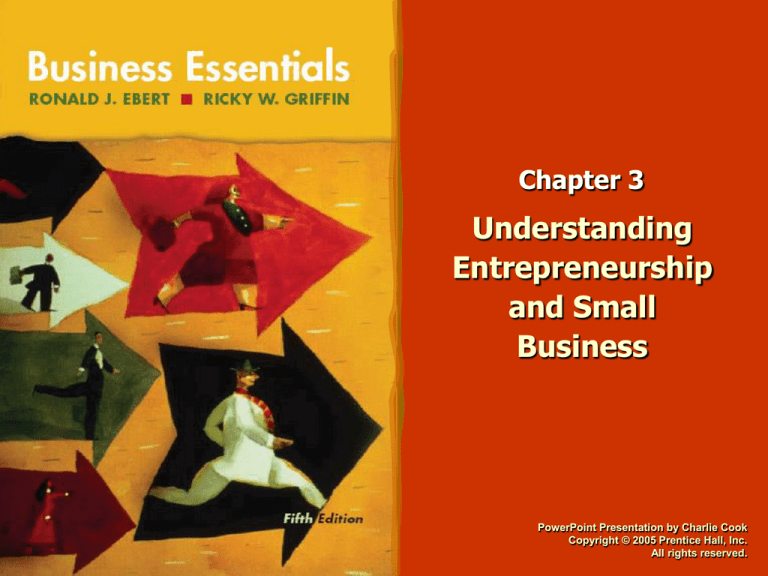
Chapter 3
Understanding
Entrepreneurship
and Small
Business
PowerPoint Presentation by Charlie Cook
Copyright © 2005 Prentice Hall, Inc.
All rights reserved.
Key Topics
• Small business and its importance in the
economy
• Entrepreneurship versus small business
• Starting and funding a small business
• Sole proprietorships, partnerships, and
corporations
• Creating and managing corporations
• Corporate trends and issues
Copyright © 2005 Prentice Hall, Inc. All rights reserved.
3–2
What Is “Small Business”?
• Independently owned and
managed business that
does not dominate its
market
Copyright © 2005 Prentice Hall, Inc. All rights reserved.
3–3
Small business plays a critical role in
the U.S. economy.
Job Creation
Innovation
Importance to Big
Businesses
Copyright © 2005 Prentice Hall, Inc. All rights reserved.
3–4
“Entrepreneurs are simply those who
understand that there is little difference
between obstacle and opportunity and
are able to turn both to their
advantage.”
—Victor Kiam
Copyright © 2005 Prentice Hall, Inc. All rights reserved.
3–5
Entrepreneurship vs. Small Business
Entrepreneur:
Accepts the risks and
opportunities of
creating, operating and
growing a new business.
Small Business Owner:
Does not have plans for
growth.
Copyright © 2005 Prentice Hall, Inc. All rights reserved.
3–6
Getting Started
Buying an
Existing Business
Copyright © 2005 Prentice Hall, Inc. All rights reserved.
Starting From
Scratch
3–7
Financing the Small Business
• Personal resources
• Loans
• Venture capital companies
• Small-business investment companies
• Small Business Association (SBA)
Financial aid and management advice
Copyright © 2005 Prentice Hall, Inc. All rights reserved.
3–8
Franchising: An Ownership Opportunity
Advantages
Proven business
opportunity
Access to
management
expertise
Copyright © 2005 Prentice Hall, Inc. All rights reserved.
Disadvantages
Start-up costs
On-going payments
Management rules
and restrictions
3–9
Trends in Small Business Start-ups
Emergence of
E-commerce
Crossovers From
Big Business
Opportunities for
Minorities & Women
Global
Opportunities
Increased
Survival Rates
Copyright © 2005 Prentice Hall, Inc. All rights reserved.
3–10
Reasons for Success and Failure
• Failure
Poor management
Neglect
Weak control systems
Insufficient capital
Success
• Hard work, drive,
dedication
• Market demand
• Strong management
• Luck!!!
Copyright © 2005 Prentice Hall, Inc. All rights reserved.
3–11
Sole Proprietorships
Advantages:
Disadvantages:
•
•
•
•
• Unlimited Liability
• Limited resources
• Limited fundraising
capability
• Lack of continuity
Freedom
Simple to form
Low start up costs
Tax benefits
Unlimited Liability
Legal principle holding owners responsible for
paying off all debts of a business
Copyright © 2005 Prentice Hall, Inc. All rights reserved.
3–12
Partnerships
Advantages:
Disadvantages:
• More talent and money
• More fundraising
capability
• Relatively easy to form
• Tax benefits
• Unlimited liability
• Disagreements among
partners
• Lack of continuity
Unlimited Liability
Legal principle holding owners responsible
for paying off all debts of a business
Copyright © 2005 Prentice Hall, Inc. All rights reserved.
3–13
What is a Corporation?
• “An artificial being, invisible, intangible, and
existing only in contemplation of the law.”
Copyright © 2005 Prentice Hall, Inc. All rights reserved.
3–14
Corporations
Advantages:
Disadvantages:
• Limited Liability
• Continuity
• Stronger fundraising
capability
• Double taxation
• Fluid control
• Complicated and
expensive to form
Copyright © 2005 Prentice Hall, Inc. All rights reserved.
3–15
Types of Corporations
• Closely Held (Private) Corporation
• Publicly Held (Public) Corporation
• Subchapter S Corporation
• Limited Liability Corporation (LLC)
• Professional Corporation
• Multinational or Transnational Corporation
Copyright © 2005 Prentice Hall, Inc. All rights reserved.
3–16
Corporate Governance Hierarchy
Stockholders
Board of Directors
Officers
Copyright © 2005 Prentice Hall, Inc. All rights reserved.
3–17
Stockholders: Owners of Corporations
• Stock: A share of ownership in a corporation
Common Stock
Preferred Stock
Copyright © 2005 Prentice Hall, Inc. All rights reserved.
3–18
Special Issues in Corporate Ownership
Joint Ventures and
Strategic Alliances
Employee Stock
Ownership Programs
(ESOPS)
Institutional
Ownership
Copyright © 2005 Prentice Hall, Inc. All rights reserved.
3–19
Special Issues in Corporate Ownership
Mergers
Mergersand
&
Acquisitions
Acquisitions
(M&As)
Divestitures
Divestitures
and
Spin-offs
& Spin-offs
Copyright © 2005 Prentice Hall, Inc. All rights reserved.
3–20
Three Forms of Business
Business
Form
Liability
Continuity
Management
Investment
Sources
Proprietorship
Personal,
limited
Ends with death
or decision of
owner
Personal,
unrestricted
Personal
General
Partnership
Personal,
unlimited
Ends with death
or decision of
any partner
Unrestricted or
depends on
partnership
agreement
Personal by
partner(s)
Corporation
Capital
invested
As stated in
charter,
perpetual or for
specified period
of years
Under control of
board of
directors, which
is selected by
stockholders
Purchase of
stock
Copyright © 2005 Prentice Hall, Inc. All rights reserved.
Copyright ©2003 Prentice Hall, Inc.
3–21
4 - 21
Chapter Review
• Define small business and explain its importance to
the U.S. economy.
• Distinguish between entrepreneurship and small
business.
• Describe the start-up decisions made by small
businesses and the potential sources of financial aid
and management advice.
• Describe sole proprietorships, partnerships, and
corporations, and explain the advantages and
disadvantages of each.
• Identify the different types of corporations.
Copyright © 2005 Prentice Hall, Inc. All rights reserved.
3–22






